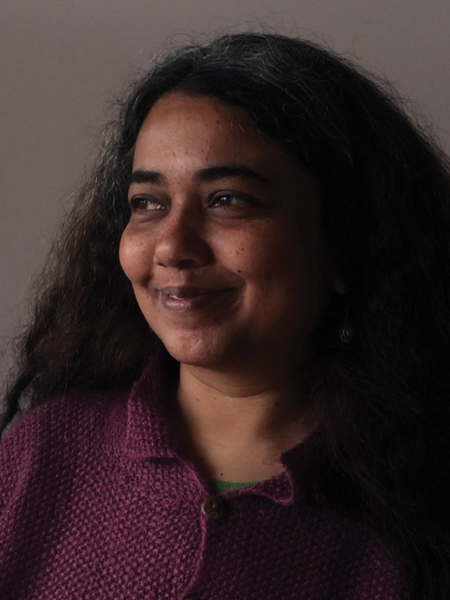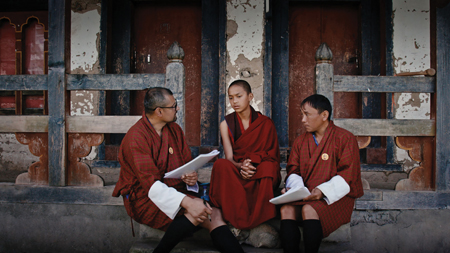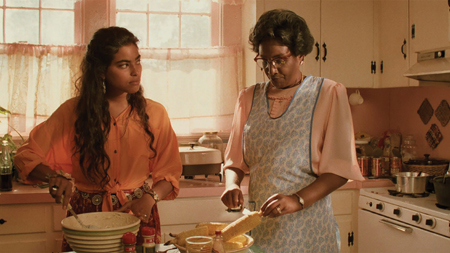Cinema: Celebrating South Asian Stories at Sundance

It is a festival for film connoisseurs hankering after sublime cinema—and now, independent filmmakers from the Indian subcontinent are starting to make their presence felt at this storied forum.
In an age where ear-splitting soundtracks are all the rage in Hollywood, we have become used to the stratospheric decibels of digitally created sounds that reverb powerfully—sometimes gratingly—throughout the theater. Now imagine a film where the soundtrack gets rave reviews because it dares to go organic— allowing both the soothing stillness as well as the natural cacophony of the sounds of the forest wildlife to come alive.
 That's exactly what we get in Nocturnes, which won the World Cinema Documentary Special Jury Award for Craft. One of the most striking of the films showcased at the Sundance Film Festival 2024, Nocturnes, by co-directors Anirban Dutta and Anupama Srinivasan, follows a researcher studying a hawk moth at the far eastern edge of the Himalayas in the dense jungles of Arunachal Pradesh. With the help of a few people from the indigenous Bugun community, the documentary explores the deep commitment and frustrations of scientific inquiry and the implications it holds for an important concern—the survival of this species of hawk moth and others in light of climate change.
That's exactly what we get in Nocturnes, which won the World Cinema Documentary Special Jury Award for Craft. One of the most striking of the films showcased at the Sundance Film Festival 2024, Nocturnes, by co-directors Anirban Dutta and Anupama Srinivasan, follows a researcher studying a hawk moth at the far eastern edge of the Himalayas in the dense jungles of Arunachal Pradesh. With the help of a few people from the indigenous Bugun community, the documentary explores the deep commitment and frustrations of scientific inquiry and the implications it holds for an important concern—the survival of this species of hawk moth and others in light of climate change.
[Right] Filmmakers Mira Nair and Ritesh Batra at the Sundance Film Festival. (Photo: Nandita Godbole)

[Left] A still from Nocturnes, winner of World Cinema Documentary Special Jury Award for Craft.
 The tone of the film is caring, with cinematographers creating deliberate pauses in the film and capturing the forest in an audio-visual delight. Both Dutta and Srinivasan said that it was important for them to focus on embracing the stillness of a magnificent forest, to hear the persistent “soundtrack” of the wildlife in chorus, and, most importantly, to recognize the beauty of being in the moment.
The tone of the film is caring, with cinematographers creating deliberate pauses in the film and capturing the forest in an audio-visual delight. Both Dutta and Srinivasan said that it was important for them to focus on embracing the stillness of a magnificent forest, to hear the persistent “soundtrack” of the wildlife in chorus, and, most importantly, to recognize the beauty of being in the moment.
Co-directors of Nocturnes, Anirban Dutta (top) and Anupama Srinivasan (bottom). (Photos: Courtesy of Sundance Institute)
 It is for gems like Nocturnes that the Sundance Film Festival is known for. Cinephiles have been coming to Park City Utah since 1978 to partake in this unique gathering of creative minds showcasing their best works. The brainchild of actor Robert Redford, the festival has become the gold standard for independent films. By many estimates, for the 2024 season, the Sundance Institute received more than 17,000 feature submissions and more than 12,000 short film submissions. Of these, only 53 short films, and less than 100 feature films were accepted for screening, putting the odds at less than one percent for making it into this elite film festival.
It is for gems like Nocturnes that the Sundance Film Festival is known for. Cinephiles have been coming to Park City Utah since 1978 to partake in this unique gathering of creative minds showcasing their best works. The brainchild of actor Robert Redford, the festival has become the gold standard for independent films. By many estimates, for the 2024 season, the Sundance Institute received more than 17,000 feature submissions and more than 12,000 short film submissions. Of these, only 53 short films, and less than 100 feature films were accepted for screening, putting the odds at less than one percent for making it into this elite film festival.
 South Asian filmmakers have been making their presence known at the Sundance for a while. Films that first screened at Sundance and made it past the arthouse theater to become commercial successes include The Lunchbox (2014), The Photograph (2019), The Farewell (2019), Minari (2020), and others. Additionally, films like Mississippi Masala (1991), Bend It Like Beckham (2002), and Blinded by the Light (2019), showcasing the complex lives of Indian immigrants, have also found their moment in the spotlight here.
South Asian filmmakers have been making their presence known at the Sundance for a while. Films that first screened at Sundance and made it past the arthouse theater to become commercial successes include The Lunchbox (2014), The Photograph (2019), The Farewell (2019), Minari (2020), and others. Additionally, films like Mississippi Masala (1991), Bend It Like Beckham (2002), and Blinded by the Light (2019), showcasing the complex lives of Indian immigrants, have also found their moment in the spotlight here.

[Left] Stills from Agent of Happiness. (Photos: Arun Bhattarai)
The 2024 lineup of South Asian films did not disappoint. Agent of Happiness, by co-directors Arun Bhattarai and Dorottya Zurbó, is set in Bhutan. It follows two agents of the Happiness Ministry of Bhutan who measure the happiness index of Bhutanese people using a large survey and long conversations. While it is heartwarming to hear the agents sing along to Bollywood tunes as they travel across the country visiting and checking in on residents, it is both endearing and heartbreaking as one is slowly drawn into the simple lives of the Bhutanese people who each define happiness differently. For some, it is about money and dreams of living abroad or how many goats they have; for others, it is about finding acceptance or even love and companionship. Much like Nocturnes, the documentary shares the kind of curiosity intrinsic to those interested in understanding our place in the world.


[Right] Dorottya Zurbó and Arun Bhattarai, co-directors of Agent of Happiness. (Photos: Courtesy of Sundance Institute)
ALOK, a short film by filmmaker Alex Hedison, is set in New York and centers around the personal life story of Alok Vaid-Menon, an internationally well-known Indian American non-binary author, poet, comedian, and public speaker. The hauntingly thought-provoking documentary offers insight into the frequently misunderstood topic of self-love and asks viewers to refine the construct of identity. This Indian  American has a lot to say, and even more to teach others, about our shared collective experience as humankind. The crisp, short film gives Alok the space to share their journey of self-expression and their empowered message of unconditional love to an audience that may struggle to accept what they do not know or understand.
American has a lot to say, and even more to teach others, about our shared collective experience as humankind. The crisp, short film gives Alok the space to share their journey of self-expression and their empowered message of unconditional love to an audience that may struggle to accept what they do not know or understand.
[Left] Alok Vaid-Menon, in a still from the film. (Photo: Courtesy of Sundance Institute)
 Two films deserve a space of their own: Mississippi Masala by Mira Nair, screened as an anniversary showing (first screened at Sundance in 1991), and Girls Will Be Girls by writer-director Shuchi Talati. Mississippi Masala was influential in exploring important themes: the emotional construct of home for Ugandan Indians forced out of Uganda under Idi Amin. It was hailed for its depiction of the relationships, tensions, and accept-ance of the brown identity in the American South. According to Nair, this film was intended to push the conversation about the tension between the black-brown dynamics and explore the possibilities of the romance of it.
Two films deserve a space of their own: Mississippi Masala by Mira Nair, screened as an anniversary showing (first screened at Sundance in 1991), and Girls Will Be Girls by writer-director Shuchi Talati. Mississippi Masala was influential in exploring important themes: the emotional construct of home for Ugandan Indians forced out of Uganda under Idi Amin. It was hailed for its depiction of the relationships, tensions, and accept-ance of the brown identity in the American South. According to Nair, this film was intended to push the conversation about the tension between the black-brown dynamics and explore the possibilities of the romance of it.
[Right] ALOK, a short film centered around the personal life story of Alok Vaid-Menon, an internationally well-known Indian American non-binary author, poet, comedian, and public speaker. (Photo: Courtesy of Sundance Institute)
 Meanwhile, Talati’s film, Girls Will Be Girls, is about the coming of age of a 16-year-old girl and is set in a hostel in the Himalayas. While the story briefly peeks into another unfortunate and familiar desi family trope: a tense mother-daughter relationship, it remains about teen youth in India: their innocence, gullibility, manipulations, and follies. It ends abruptly—where while one relationship is mended, another ends. Girls Will Be Girls won the Audience Award in the World Cinema Dramatic category and the Special Jury Award for Acting for its lead actor, Preeti Panigrahi.
Meanwhile, Talati’s film, Girls Will Be Girls, is about the coming of age of a 16-year-old girl and is set in a hostel in the Himalayas. While the story briefly peeks into another unfortunate and familiar desi family trope: a tense mother-daughter relationship, it remains about teen youth in India: their innocence, gullibility, manipulations, and follies. It ends abruptly—where while one relationship is mended, another ends. Girls Will Be Girls won the Audience Award in the World Cinema Dramatic category and the Special Jury Award for Acting for its lead actor, Preeti Panigrahi.
[Left] Alex Hedison, director of ALOK. (Photo: Courtesy of Sundance Institute)


The problem of defining the target audience
Arthouse films are designed to make the audiences think. Films from Asia are generally deft at weaving enough cultural nuances and elements into the narratives that infuse them with warmth and character including evocative cinematography and poignant observations around relationships.
But, within them, a larger question looms for arthouse films with a desi angle: who is the audience and how does it influence an everyday person, the everyday desi?
[Right] Stills from Mira Nair’s groundbreaking Mississippi Masala. (Photos: Courtesy of Sundance Institute)
While Nocturnes and ALOK are sharp and direct documentaries with very clear messaging, others leave the audience with many open-ended questions. An audience that may have been able to appreciate Guess Who is Coming to Dinner (1967) back when it was released, may only see Mississippi Masala as a slightly pivoted and recast story with brown characters. A brown audience hungry to see themselves on screen may have a different view. For many Indian-origin immigrants who were already settled in the U.S. in 1991, this film was about acceptance and desi pride on a global stage. To young immigrants, especially students who were in the U.S., unfamiliar with the juxtaposition of race, identity, and belonging in the South, this film was centered around its eros.

Fast forwarding to the present day, many older adults, particularly brown women who first watched it as a young person, wonder how much of their life experiences and interpersonal connections with other adults in the U.S. have been influenced or—in many cases—tainted by the connotations around the word “masala.” The Gen Z audience may not see it for its social implications on brown women of the time but, instead, as a first-of-its-kind film and revel in the romantic notion of a vintage and classic film.
[Left] Shuchi Talati, writer-director of Girls Will Be Girls (Photos: Courtesy of Sundance Institute)

[Right] A still from Girls Will Be Girls. (Photo: Courtesy of Sundance Institute)
In the same breath, if films with desi characters are for an Indian audience that sees sex education as a taboo topic, then the premise in Girls Will Be Girls will likely invite crass or risqué reviews as it already has in Indian dailies. It begs an introspective viewer to question why conversations around first crushes and sexual behavior among teens are still difficult in Indian culture and are considered taboo for girls and women but not among boys or men. While shows like Never Have I Ever seem wildly liberating for many progressive Indian-origin parents raising young people in the U.S., these are still not easy in India, especially for mothers and daughters who may carry, or unwittingly perpetuate, harmful legacies. If such films are banned in a country where the abuse of women, especially underage young adults; poor sex education; and misogyny are pervasive problems, Girls Will Be Girls can have an unsettling effect.

The odds of a film being accepted at the elite Sundance Film Festival are less than one percent! (Photo: Jen Fairchild)
If Girls Will Be Girls is only meant for audiences outside India, then it leaves one wondering if this is the making of a brown Lolita or a brown Brooke Shields, or if it perpetuates hurtful narratives that impact, pressurize, or coerce impressionable brown youth into unhealthy behavioral patterns.
The Sundance Festival isn’t for everyone and yet it is for everyone. All in all, the screens offered much to mull about and discuss candidly, especially as they relate to South Asia identity including race, social expectations, interpersonal behavior, as well as our relationships with ourselves, each other, a romantic interest, a passport, the natural world, and politics.
But, like the short lifespan of the hawk moth from Nocturnes, offering so much to reflect upon about global climate change, audiences will have to wait to know if the enduring success, or effervescent but ephemeral quality, of any of these films will impact the future of the culture of storytelling from Asia. That only time can tell. And perhaps, that’s where the beauty and the conundrum of it lies.
Nandita Godbole is an entrepreneur, cookbook author, and speaker in the food and wellness space. Masaleydaar: Classic Indian Spice Blends is her most recent book.
Enjoyed reading Khabar magazine? Subscribe to Khabar and get a full digital copy of this Indian-American community magazine.
blog comments powered by Disqus











